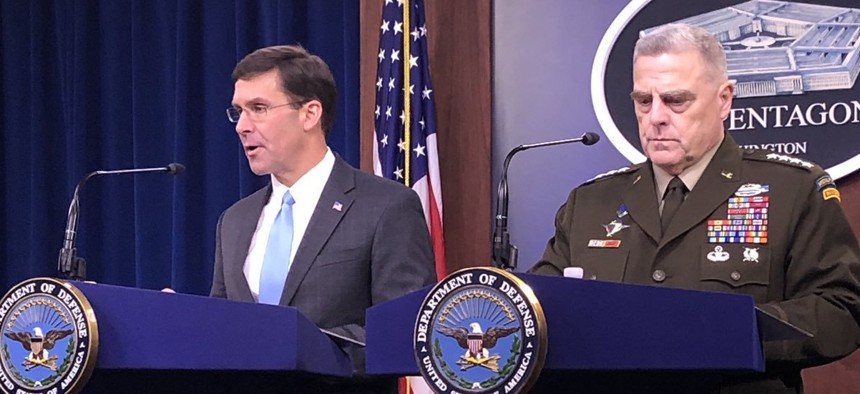
Defense Secretary Esper and Gen. Mike Milley address the press at the Pentagon briefing room on Fri., Oct. 11, 2019. Kevin Baron / Defense One
Defense Secretary: I Can't Put Forces Between Turks and Kurds
Esper explained why the U.S.-backed rebels will get no air cover or other help. But he couldn't explain why U.S. troops were moved after this particular Turkish threat to invade.
Pentagon leaders on Friday said Turkey’s decision to cross the border and attack U.S.-supported Kurdish militia groups left the United States little choice but to pull its own troops out of the way.
Defense Secretary Mark Esper denied that the U.S. military had abandoned the Syrian Democratic Forces, noting that the United States would continue to arm and advise the rebel forces as they fought ISIS in other parts of Syria. But he made clear that the United States would not defend the SDF against a NATO ally bearing down on them with airstrikes, artillery, and armor.
"We are not abandoning our Kurdish partner forces and U.S. troops remain with them in other parts of Syria,” Esper told reporters, days after the White House announced that it would pull 50 U.S. troops out of the way of the expected Turkish attack.
"We remain in close coordination with the Syrian Democratic Forces, but I will not place American service members in the middle of a longstanding conflict between the Turks and the Kurds,” he said. “This is not why we are in Syria.”
Esper blamed the timing of the U.S. troop withdrawal entirely on Turkish President Recep Tayyip Erdogan. Next to him in the Pentagon press-briefing room, Gen. Mark Milley — the new chairman of the Joint Chiefs of Staff — sought to downplay the extent of the Turkish incursion into Syria. Milley said hundreds of Turkish troops and around a thousand Turkish-backed Syrian rebels had advanced between five and 10 kilometers into Syria in the western parts of a 125-kilometer stretch of the border and between one and three kilometers in the eastern reaches of that stretch. Milley called this a “relatively limited” incursion.
Turkey has repeatedly threatened to attack the U.S.-allied SDF, which is the militia arm of a Kurdish separatist group that Ankara considers to be terrorists. But it had never followed through on those threats until Wednesday, when it began launching air and artillery strikes into northeastern Syria. The assault began just days after President Trump had a phone call with Erdogan and then announced that the United States would remove its soldiers from a border zone that it was patrolling alongside Turkish troops.
Asked why the withdrawal of U.S. troops was necessary now, and had not been after any of the previous Turkish threats to attack, Esper stammered that the Pentagon had been “concerned” about a possible Turkish incursion since he took office in July and that his “job number one” had been “to hold the Turks back from making this incursion.”
“I can’t explain why they did what they did. Clearly President Erdogan felt the need at this point in time,” he said. He insisted that “nobody greenlighted” the Turkish operation.
The Pentagon has told Turkey that it does not support the operation, Esper said, on the grounds that it threatens the defeat-ISIS mission and endangers U.S. service members and their Kurdish allies. But Esper said that he had spoken with his Turkish counterpart on Thursday, and had seen “no indication they are willing to stop.”
Esper and Milley emphasized that the United States would not offer any kind of air support or no-fly-zone to the SDF, which has asked urgently for both.
“There is no SDZ that I’m aware of that allows us to conduct military operations in support of the Kurds against the Turks, a 70-year NATO ally,” Milley said.
Esper and Milley insisted that the U.S. is still working with the SDF in other parts of Syria to continue the fight against ISIS. (U.S. officials privately say that the counter-ISIS campaign has effectively ground to a halt as SDF fighters have rushed to the Syrian-Turkish border to defend their territory.)
“Right now, we do have forces co-located [with the SDF] and we’re asking them to continue their partnership with us and continue their — a lot of it is force protection of our forces, and so on,” Milley said. “We’re encouraging them not to overreact at this point and to try to tamp things down in order to try to allow some sort of diplomatic resolution.”
The United States and Turkey over the summer had established a so-called “security mechanism,” designed to address Turkish concerns about the SDF and prevent an attack. The U.S. and Turkish militaries conducted joint patrols and fly-overs on the border of Syria and Turkey, and established a coordination center in southern Turkey. “We were doing all the things we agreed to do,” Esper said.
As part of that security deal, the SDF had complied with U.S. requests to pull back its own defensive fortifications — leaving them vulnerable when Turkey attacked.
The fifty redeployed troops, whose job was to participate in joint patrols with Turkey as part of the security mechanism, were seen as a deterrent against Turkish invasion — not because they would have exchanged fire with Turkey but because Turkey would not want to risk accidentally harming NATO-allied American service-members in the course of their assault.
Trump has said that his decision to pull back the fifty troops is part of his effort to end the U.S.’s “endless wars” in the Middle East.
“Look, we have no soldiers in Syria,” Trump said, falsely, on Thursday. “We’ve won. We’ve beat ISIS. And we’ve beat them badly and decisively. The last thing I want to do is bring thousands and thousands of soldiers in and defeat everybody again. We’ve already done that.”
The U.S. still has a thousand soldiers in Syria, who have been conducting ground operations, stabilization efforts and the occasional airstrike on ISIS targets.
“Right now the policy of the United States is to continue with our conter-ISIS campaign, and we are continuing with our operations — except in that one area of the incursion,” Milley said.







